

20 Tips for Creating a Professional Learning Network - Getting Smart by Miriam Clifford. “20 Tips for Creating a Professional Learning Network” by Miriam Clifford first appeared on the InfomED blog.
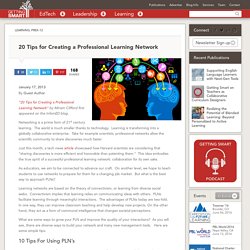
20 Tips for Creating a Professional Learning Network. Networking is a prime form of 21st century learning.
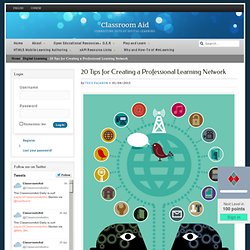
The Right Way is Your Way. I have read some very thought-provoking posts and associated commentary over the past couple of weeks focusing on how particular educators use social media.
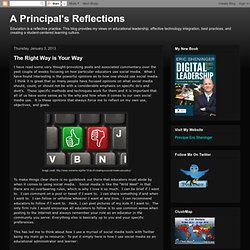
20 Ways To Improve Your Professional Learning Network In 2013. Networking is a prime form of 21st century learning.
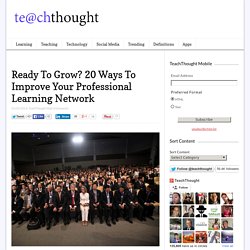
The world is much smaller thanks to technology. Learning is transforming into a globally collaborative enterprise. Take for example scientists; professional networks allow the scientific community to share discoveries much faster. Just this month, a tech news article showcased how Harvard scientists are considering that “sharing discoveries is more efficient and honorable than patenting them.” This idea embodies the true spirit of a successful professional learning network: collaboration for its own sake. Network or Perish. I know, a bit of a harsh title for this post but I got your attention… Seriously though, networking has for the most part always been important to being successful in whatever you pursue.

I think technology though has significantly amplified the importance of networking. 8 Ideas, 10 Guides, And 17 Tools For A Better Professional Learning Network. Personal learning networks are a great way for educators to get connected with learning opportunities, access professional development resources, and to build camaraderie with other education professionals.

Although PLNs have been around for years, in recent years social media has made it possible for these networks to grow exponentially. Now, it’s possible to expand and connect your network around the world anytime, anywhere. But how exactly do you go about doing that? Check out our guide to growing your personal learning network with social media, full of more than 30 different tips, ideas, useful resources, and social media tools that can make it all possible. Tips & Ideas. Flipping PD - iPads in Education.
PD: How do educators get to know what they don’t know? SmartBlogs. When it comes to education reform, there are in general two major camps, but there are also several variations of each.

The first camp would like to blow up the system and start all over. The other camp wants to continue the status quo while working to change it in directions governed by whatever dominant force of change has the ear of the public at the time. I find my own inclinations falling somewhere between the two camps. I want to blow some stuff up while improving upon some existing stuff.
Like most educators, or any people with a basic understanding of authentic assessment, I do want to blow up any notion or hint of compliance with high stakes, standardized testing. 10 Ways You Can Use Social Media for Self-Education. You probably think that social networks are for fun only.
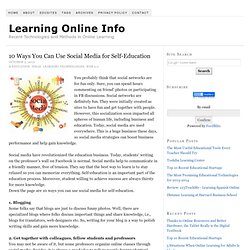
Sure, you can spend hours commenting on friend’ photos or participating in FB discussions. Social networks are definitely fun. They were initially created as sites to have fun and get together with people. 21st-Century PLNs for School Leaders. As many school administrators are enjoying their summer break, we all tend to think of ways that we can make our school better in the upcoming year.
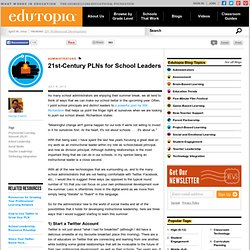
Doug - off the record. Recently, I wrote a series of posts about Professional Learning with Social Media.

It was inspired by comments from @tk1ng about conversations that he had with young teachers during a summer Additional Qualifications course. I’m going to use this post to put them all together. I’m hoping that the totality of the comments makes sense and that, perhaps, at least one of Tim’s co-learners stumbles on this blog post and reconsiders. I absolutely read every comment that’s posted to this blog. Often, it allows me to extend the conversation. But, one of the quotes in his reply made me think during my morning dog walk. 21st Century PLNs for School Leaders. Cc licensed ( BY ) flickr photo shared by krossbow I have to admit that I was pretty excited to write my first post for the Edutopia group that has a great list of educators sharing some of their best practices. I wanted to share the piece in my own learning space, but you can see the original article posted on the Edutopia site. As many school administrators are enjoying their summer break, we all tend to think of ways that we can make our school better in the upcoming year.
Friending cats and following eggs: On social networks you ARE your photo. On social networks, you ARE your photo. Your image is important! The photo you choose to represent you says a great deal about who you are as an individual. It is your personal brand. I love meeting people in person at conferences or cocktail parties and then connecting with them on social networks like LinkedIn, Facebook, and Twitter. Sometimes I search people out and connect and other times they find me. 5 Reasons Educators Should Blog. My daughter Abby (with the Mac) and my niece Ashley Once a week, a new to-do pops up on my productivity software client that alerts me that it’s time to do a blog entry. Most of the time I admire the line and proceed to complete a dozen other tasks that, if not completed, will affect my job performance.
Asking Questions In Social Media – Key To Building Relationships. At the age of seventeen, my first mentor in business was Nic Knievel, Bob (or Evel Knievel’s) brother. Opening the Curtain on Lurking. Act One. The scene is a large conference room. Laptops and iPads litter the tables that stretch from one end of the room to the other. Black power cords snake vine-like over and around the men and women in numerous chairs. They seem to wriggle out from the floor and the table legs and the leather attaché cases, in search of outlets. At rise, we meet our subject of interest, seated back left, third row. Act Two. With this, her eyes are opened and her approach to the role she plays in this ensemble is no longer self-centered, riddled with worry about sounding uninformed or being cast aside as useless. But, with newfound confidence and involvement comes newfound respect and, consequently, responsibility.
A Sustainable Start : Develop a PLN. Sketchy Explanation: Starting a PLN.